Figure 1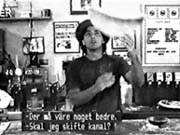 |
Figure 2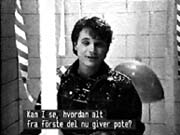 Starke: Notice how everything we set up in the first reel pays off in the last? |
Figure 3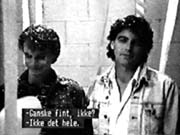 Starke: Pretty slick, huh? Clooney: Not everything. |
Figure 3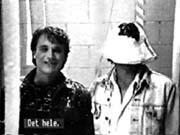 (The pizza dough lands on Clooney's head.) Starke: Everything. |
Early in The Return of the Killer Tomatoes (John DeBello, 1988), the
character played by George Clooney throws a disc of pizza dough up into the
air, pizzaiolo fashion (Figure 1), and the action continues with no shot of the
dough redescending. In the final moments of the film, Anthony Starke and
Clooney address the audience on the subject of the film's construction (Figures
2-4).
Figure 1 |
Figure 2 Starke: Notice how everything we set up in the first reel pays off in the last? |
Figure 3 Starke: Pretty slick, huh? Clooney: Not everything. |
Figure 3 (The pizza dough lands on Clooney's head.) Starke: Everything. |
While this example does not especially illuminate the nature of the set-up/pay-off figure, it shows that those concepts are so widely used within American film culture that audiences can be expected to understand a gag based on them, at least in a spoof on low-budget cinema.
Yet the terms set-up and pay-off do not appear in standard works on film. No entries are devoted to them in such comprehensive reference books as Ira Konigsberg's The Complete Film Dictionary (New York: Meridian, 1989) and the new edition of Ephraim Katz's Film Encyclopedia (New York: Macmillan, 1994). That the same is true of standard film bibliographies, such as the International Index to Film Periodicals and the Film Literature Index, suggests that no articles are being written with those concepts in their titles. Nor is the set-up/pay-off figure even mentioned in such widely used introductions to film æsthetics as David Bordwell and Kristin Thompson's Film Art: An Introduction (New York: McGraw-Hill, 1993; Fourth Edition) and James Monaco's How to Read a Film (New York: Oxford University Press, 1981). It is to David Howard and Edward Mabley's credit that these authors devote a page and a half to what they call "planting and payoff" in The Tools of Screenwriting. A Writer's Guide to the Craft and Elements of a Screenplay (New York: St. Martin's Press, 1993; pp. 78-79), thereby providing one of the rare evocations of the figure in the literature on film, though no rigorous definition is included in their discussion.[1]
In the present article, definitions of set-up and pay-off will be proposed, then illustrated with examples from four films, after which the set-up/pay-off figure will be compared and contrasted to a somewhat related narrative strategy based on the juxtaposition of threat and relief.
1. It provides information in the light of which some future event, which would otherwise have no particular significance for us, becomes charged with meaning.A pay-off is defined here as a narrative event with the following properties:2. It must make enough of an impression on us for it to be subject to recall when the time comes, though nothing prevents the filmmaker from reminding us of the information provided in the set-up, just before the pay-off is delivered.
3. It must not be recognizable as a set-up, which in turn means that it must be naturally rooted in the narrative, with its own justification for being there, and seemingly with no ulterior motive on the part of the filmmaker. If it is planted in so obvious a way that the public can spot it as a set-up, the figure is no more successful than a joke whose punch line you can see coming from a mile away.
4. It cannot be an entirely negative event. If it involves a defeat for the hero, it must have at its core some positive intention, some life- affirming or spiritually admirable quality.
1. It must be an emotionally rewarding and meaningful experience for the public, ideally providing a euphoric rush.2. Its meaning is intelligible to us on the basis of the information provided in a previous event - the set-up; if it would be just as meaningful without a set-up, it is not a pay-off.
3. It therefore invariably involves an experience of recognition on the part of the public.
Focusing on the life of a middle class family in England during the Second World War, this is one of a number of films designed at the time to strengthen American support for the British allies.
Early in this film, a set-up is maneuvered into place when Vin, the son who has just won his pilot's wings in the R.A.F., tells his parents and sweetheart during a brief visit home:
Figure 5
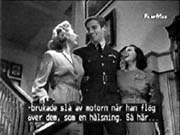 Vin: Hey, what a bit of luck being transferred to an airfield so near! Say, a fellow I knew at the last airfield had his people living round about, and whenever he flew over, he would cut his engines so they could tell who it was, you know - like this (he imitates sputtering engine sounds with his lips). |
Vin returns to his airfield, and that night, as his parents Kay (Greer Garson) and Clem (Walter Pidgeon) lie in bed, they hear the sound of planes passing overhead, and an initial pay-off is provided. Although this scene follows only minutes after the set-up is established, Wyler was presumably unsure that his audience would remember Vin's words, since he has Kay remind us of them by correcting Clem's obtuseness, and in the process explicitly linking set-up and pay-off:
Figure 6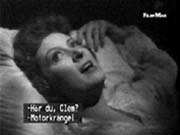 Kay (hearing an engine being cut): Listen, Clem. |
Figure 7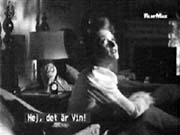 Clem: What? Engine trouble. Kay: No, it's Vin. Clem: Vin? | |
Figure 8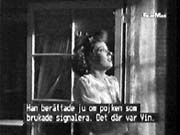 Kay: Yes, don't you remember what he told us about signaling? About the boy who signaled his mother? It's Vin. Clem: By Jove, I think you're right. |
Figure 9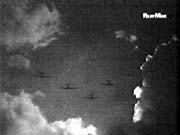 | |
| ||
A second pay-off is provided much later in the film, at a point when months of story time have gone by without any word from the young pilot. His family is naturally afraid that he has been injured or killed. Clem has just returned from Dunkirk, utterly exhausted, and after Kay tucks him in, she hears the sound of airplane engines in the sky above. This second pay-off is given a visual quality very different from the first one, in order to minimize the degree of overlap between the two events. This time, Kay is seen in an exterior shot as she leans out of the sun-drenched window, and there is no shot of planes in the sky (as in Figure 9 above), but only of the moving shadows they cast on the house and on Kay as they fly overhead.
Figure 11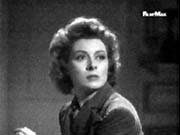 |
Figure 12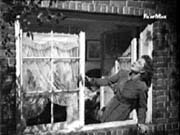 |
Figure 13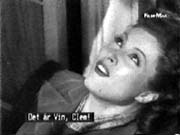 Kay: It's Vin, Clem it's Vin. He's back. |
Here we have the three hallmarks of a pay-off: the reward, in the emotional relief that Vin is safe; the link to the set-up as a basis for intelligibility and meaning; and an experience of recognition. In this particular case, the earlier pay-off could be seen as preparing us for the later one, and in that respect, the initial pay-off might be considered to be part of the set-up for the final one, thereby precluding any need for a new reminder as to what the unusual engine sounds signify.
2. One Flew Over the Cuckoo's Nest (Milos Forman, 1975)
In describing the properties of set-ups on page 55 above, I suggested that a set-up cannot be an entirely negative event, and that if it involves a defeat for the hero, it must have at its core some positive intention, some life-affirming or spiritually admirable quality. The present example was chosen primarily to illustrate that point.
Approximately 30 minutes into One Flew Over the Cuckoo's Nest, McMurphy (Jack Nicholson) loses a vote as to whether or not he and the other patients in his ward will be allowed to watch the World Series on television. In the next scene, he announces to his fellow patients that he intends to break out of the hospital and watch the World Series in a bar. His means of escape: throwing a 400 pound control panel - a huge cement block with water hoses and gauges - through the mesh covering the window. Whether or not he can lift and carry the panel becomes the subject of a bet.
Figure 14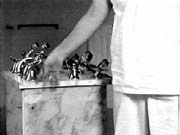 McMurphy: ...I'm going to take this fuckin' thing, I'm going to put it through the window (reaction shot of Chief Bromden), and me and my buddy Cheswick are going to go out through the wall, down town, sit down at a bar, wet our whistles and watch the ball game. |
Figure 15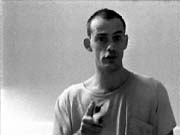 McMurphy: And that's the bet. Now does anybody want any of it? Taber: You're going to lift that thing? McMurphy: Yeah, that's right. Taber: I'll bet a buck. McMurphy: Taber, one dollar. Devito-character: I bet a dime. |
Figure 16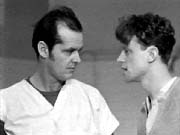 Billy (to McMurphy): Ca-can't li-lift that thing. McMurphy: Anybody else want any of it? Hard-on? |
Figure 17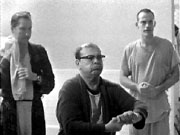 Harding: I'll bet $25. McMurphy: $25, Hard-on. |
Figure 18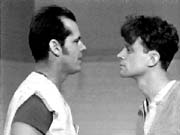 Billy: Nobody can ever, ever lift that thing. McMurphy: Get outa my way. You're using my oxygen, you know what I mean? |
Figure 19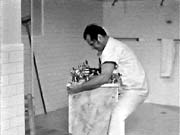 McMurphy struggles to lift the control panel, then releases his grip. Harding: Giving up? McMurphy: No, just warming up. Warming up. (To the object as he tries again to lift it) Come on, be there. (As McMurphy grunts, Billy looks away.) |
Figure 20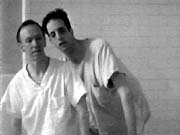 |
Figure 21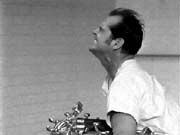 |
Figure 22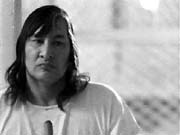 |
Figure 23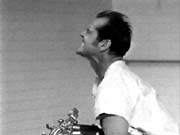 |
Figure 24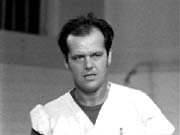 McMurphy gives up and heads grimly toward the door. |
Figure 25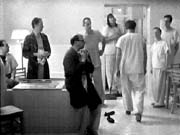 McMurphy (leaving the room): But I tried, didn't I, goddamit. At least I did that. |
While the outcome of this episode is clearly one of defeat for McMurphy, his attempt to lift the control panel is presented as a daring defiance of limitations - the opposite of the fearful resignation shown by his fellow patients. In this respect, even though he fails, McMurphy provides a model for defying the worst odds in what is essentially a struggle for freedom and an affirmation of the human spirit. This lesson wil not be lost on Chief Bromden (Will Sampson).
At the end of the film, after the Chief smothers what is left of McMurphy, he takes on the spirit of revolt McMurphy had embodied and our identification is transferred to him as he follows his friend's example.
Figure 26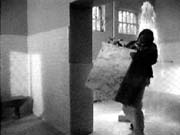 |
Figure 27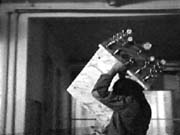 |
Figure 28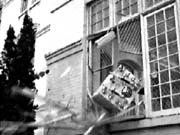
|
In the final shot of the film, Chief Bromden heads into the forest, leaving the hospital and everything it stands for far behind him.
In this particular case, it could be argued that the pay-off would have been just as satisfying if it hadn't been set-up by the earlier scene. The Chief would still be breaking out of his prison and bound for freedom. But this act of self-liberation would not have had the same meaning - designating the Chief as the inheritor of McMurphy's spirit - unless it picked up where the earlier scene had left off, finishing McMurphy's unfinished business. Here the pay-off is the fulfillment of the set-up.
3. Little Big Man (Arthur Penn, 1979)
The young Jack Crabb (Dustin Hoffman), who has been parked at a soda fountain by Mrs. Pendrake (Faye Dunaway) while she meets her lover in the cellar of the soda shop, is fascinated by the spigot (Figure 14). As he admires and plays with it, we hear the 121-year-old Jack Crabb's voice- over telling us about the event as he remembers it:
Figure 29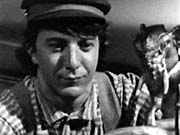 Voice-over as an old man, looking back: That soda shop was somethin'. Especially that elephant-head spigot. I was playin' with it and enjoyin' myself then, all of a sudden, an awful feelin' ran through me. Where had that fellow gone to? |
Having made the spigot a focus of interest for young Jack and us for a full 30 seconds, the filmmaker then suddenly changes the subject, shifting our attention to Jack's discovery of the true purpose for Mrs. Pendrake's visit to Mr. Kane's soda shop.
Years later, Jack is captured by the Cheyenne who had raised him, and is brought to the tent of his adoptive grandfather, Old Lodge Skins (Chief Dan George). The old relationship is re-established. After Old Lodge Skins tells about his dream (Figure 30), the old Jack Crabb's voice-over explicitly links the dream to the set-up (Figure 31).
In this case, the linking may have been done for us, not only to help us to remember the set-up. but also because the pay-off defies our understanding and in that respect, some comment acknowledging the inexplicable nature of Old Lodge Skins' dreams was probably considered necessary.
Figure 30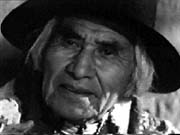 Old Lodge Skins: I saw you in a dream. You were drinking from a stream that came from the long nose of an animal. I did not recognize the animal. Alongside his nose, he grew two horns. And the water that gushed from his nose was full of air! |
Figure 31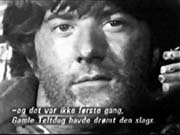 Jack's voice-over, looking back as an old man: I couldn't explain it but he was talkin' about that elephant- head spigot in the soda shop and this wasn't the only time Old Lodge Skins had dreams that turned out to be true... |
Here, however, the reward involved in the pay-off is more complex than in the example drawn from Mrs. Miniver.
Before this scene begins, Old Lodge Skins has already won our affection and admiration. From this point on, he embodies in our eyes not only the wisdom and humanity so utterly lacking in those figures in authority in the white man's society, as portrayed in Little Big Man, but also powers that cannot be explained. And it is immensely pleasurable for us to see him invested with those powers, which also in a way confirms everything else he says and stands for in the film.
At the same time, of course, he has no idea that the animal in his dream is an elephant, nor that the water full of air is carbonated mineral water. Nor does he know how remarkable his dream actually is. But we know, as does Jack Crabb who shares his wonderment with us. And Old Lodge Skins' not having a clue as to how astonishing he is as he tells his dream, enhances our pleasure even more.
4. RoboCop (Paul Verhoeven, 1987)
Early in the film, before police officer Murphy (Peter Weller) comes to any harm, his female partner, Lewis (Nancy Allen), sees him practice twirling his service pistol:
Figure 32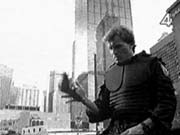 |
Figure 33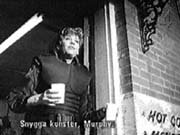 Lewis: Pretty fancy moves, Murphy. |
Figure 34 Murphy: Ah, yeah, well my son Jimmy watches this cop show, "T. J. Laser," and this Laser guy does this every time he takes out a bad guy. |
Figure 35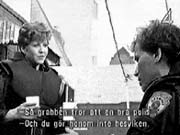 Murphy: So naturally my kid thinks I'm a good cop... Lewis: And you don't want to dis appoint him. Murphy: Yeah, well, role models can be very important to a kid. |
After Murphy has been slain by the gang of villains, his body is reconstructed with artificial parts to replace those that had been mutilated. Here, Lewis sees the new supercop at target practice, as he makes a phenomenal score and utterly destroys the target:
Figure 36 |
Figure 37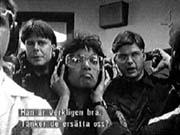 Male cop: This guy is really good! Female cop: He's not a guy, he's a machine. Male cop: What are they going to do, replace us? |
Figure 38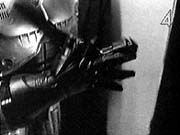 Before RoboCop replaces the gun in its holster, he twirls it as Murphy had done. |
Figure 39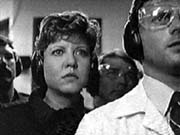 Lewis sees this twirl ing of the gun and reflects on its significance. |
Having lost our hero, Murphy, when he is killed at the hands of the villains, we have gotten him back again in his reconstructed form as RoboCop. But is it really he, or is it just a machine (as the woman cop says in Figure 37)? The twirling of the gun gives us our answer and shows that it really is Murphy we have gotten back. It is through Lewis' understanding of the situation that this realization comes about, just as she was a part of the set-up. Needless to say, this knowledge that Murphy's personality is alive, and this feeling that we have recovered our hero, is tremendously satisfying to us.
In addition to the emotionally rewarding aspect of the scene, the other hallmarks of a pay-off are also present: the intelligibility and significance of the gun-twirling on the basis of the set-up, and the aspect of recognition - which in this case is left to us, though officer Lewis's attentiveness to the gesture certainly serves as a cue.
The four examples given here should be adequate to illustrate the basic contours of the set-up/pay-off construct, which can now be compared to a somewhat related figure.
John MacReedy (Spencer Tracy), a one-armed war veteran, turns up in a small and isolated town, looking for the father of a soldier from his outfit - a Japanese-American soldier who had been killed in the war. It turns out that the man MacReedy is looking for was the victim of a racial killing carried out by the men of Black Rock, who now feel threatened by MacReedy's snooping and who are determined to get rid of him, one way or another.
Having run him off the road in an attempt to scare him out of town, the bully Trimble (Ernest Borgine) tries to pick a fight with MacReedy, who has just entered a diner and ordered some lunch. Trimble's cohorts, including Reno Smith (Robert Ryan) and Hector David (Lee Marvin), are also present as Trimble's behavior toward MacReedy becomes progressively more threatening. With each successive aggression, it is as though a spring is compressed more and more (Figures 40-44), until a limit is reached - in this case, when Trimble touches MacReady (Figure 45) - and the spring bursts back into its distended position, reversing the situation and providing us the longed-for relief (Figures 46-49).
Figure 40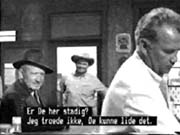 Trimble: Well, still around? I thought you didn't like this place. MacReedy: You mean going to or coming from? Trimble: Staying put. MacReedy: No comment. Trimble: No comment, he says. And all the time he's got my stool. (MacReedy moves to another stool.) |
Figure 41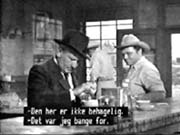 Trimble(now seated on the stool Mac Reedy vacated): This stool ain't com fortable. MacReedy: I was afraid of that. Trimble: I think I'd like the one you're on. Reno: Changeable as a prairie fire. MacReedy(to Trimble): Suppose you tell me where to sit. |
Figure 42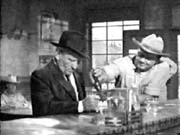 Trimble(pouring ketchup onto Mac Reedy's beans): I hope that ain't too much. MacReedy(to Reno): Your friend's a very argumentative fellow. Reno: Kind of unpredictable too. Got a temper like a rattlesnake. Trimble(to MacReedy): That's me all over. I'm half horse, half alligator. You mess with me and I'll kick a lung out of you. What do you think of that? MacReedy: No comment. |
Figure 43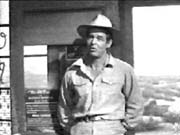 Trimble: You know talking to you is like pulling teeth. You wear me out. (Shouting.) You're a yellow-bellied Jap- lover. Am I right or wrong? MacReedy: You're not only wrong, you're wrong at the top of your voice. Trimble(removing his wristwatch): You don't like my voice? MacReedyto Reno: I think your friend is trying to start trouble. Reno: Why ever would he want to do that? |
Figure 44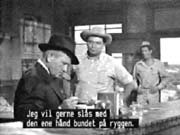 MacReedy: Well, I don't know. Maybe he thinks that if he needles me enough, I might crack. I might even fight back. And then either he or your other ape sitting over there could beat me to death and then cop a plea of self- defense. Reno: I don't think that'll be necessary. You're so scared now you'd probably drown in your own sweat. Trimble(to Reno): No, before that happens. (To MacReedy.) Couldn't I pick a fight with you if I tied one hand behind me? |
Figure 45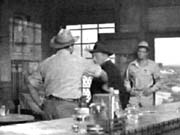 MacReedy rises from his stool, pays and heads for the door. Trimble puts his hand on MacReedy's shoulder and spins him around so that the two are facing one another. Trimble: If I tied both hands? |
Figure 46 MacReedy gives Trimble a rabbit punch to the throat. Trimble is thrown to a wall and gasps for breath. Reaction shots of Reno and Hector. |
Figure 47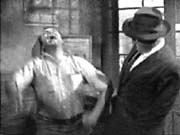 Trimble then takes a swing at Mac Reedy, only to receive another punch in the back of the neck, then a knee in the chin. Trimble hits the wall again and is bleeding from the mouth. |
Figure 48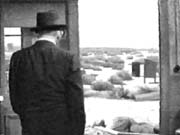 He takes yet another swing at MacReedy and gets two rabbit punches in the back, that send him flying into the diner's screen door which gets torn from its hinges, framing him as he falls to the ground outside the entrance. Reaction shot of Hector. |
Figure 49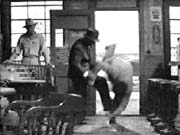 MacReedy stands there calmly, watching Trimble struggle to his feet and try to punch him one last time. MacReedy brings Trimble to the ground with a judo move. |
One advantage to distinguishing between them is that there are cases in which both figures are operative in the same filmic situation, and unless their differences are kept it mind, it would be easy to overlook the possibility that both are in play.
This is the case in the memorable airport scene at the end of Casablanca (Michael Curtiz, 1942), when Rick (Humphrey Bogart) has shot Major Strasser (Conrad Veidt) in order to prevent him from interfering with the departure of Ilsa Lund (Ingrid Bergman) and Victor Laszlo (Paul Henreid), as Captain Renault (Claude Rains) looks on. Upon the arrival of a carload of Vichy police, Captain Renault now has the upper hand, and our hero is very much in danger of being arrested and sent off to a concentration camp.
It is at this tense moment that Captain Renault turns to his men who have just arrived and states: "Major Strasser has been shot." He and Rick then exchange meaningful glances, then Renault turns to his men again and utters the words: "Round up the usual suspects."
Figure 50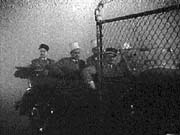 |
Figure 51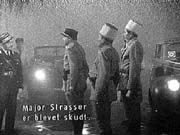 Renault (to his men): Major Strasser has been shot. |
Figure 52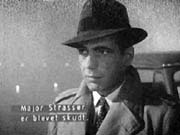 |
Figure 53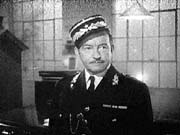 |
Figure 54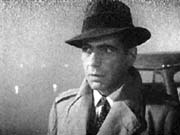 |
Figure 55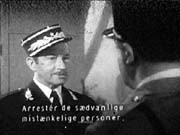 Renault : Round up the usual suspects. |
Here, we clearly have a threat/relief figure, with the Captain's words turning the situation around, and getting Rick off the hook.
But "Round up the usual suspects" is also a pay-off, referring to lines spoken early in the film by Captain Renault in answer to a question asked by Major Strasser, moments after the Major's arrival at Casablanca, also in an airport scene:
Figure 56 Strasser : By the way, the murder of the couriers, what has been done? |
Figure 57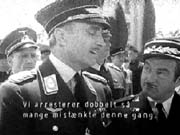 Renault : Oh, realizing the importance of the case, my men are rounding up twice the usual number of suspects. |
This set-up is in turn prepared in an even earlier scene, in which a pickpocket (Curt Bois), speaking to his unsuspecting victims, explains what is going on in the street:
Figure 58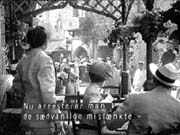 Pickpocket: Two German couriers were found murdered in the desert, the unoccupied desert. |
Figure 59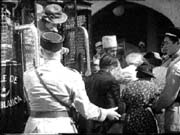 Pickpocket: This is the customary round up of refugees, liberals and, of course, a beautiful young girl for Mon sieur Renault, the Prefect of Police... |
The history of the line, "Round up the usual suspects," which was thought up by Julius and Philip Epstein, is worth considering at this point.
The first draft of the screenplay for Casablanca, which had been written by the Epstein brothers, had been given to Howard Koch to complete. But with the end of production rapidly approaching, neither Koch, director Curtiz nor producer Hal Wallis could come up with a satisfactory ending, and the problem was turned over to the Epsteins to solve.
Julius and Philip Epstein were twin brothers who were so much in tune with one another's way of thinking that they could finish each other's sentences. As the story goes:
Late one night as they were driving toward Beverly Glen, the Epsteins turned to each other at exactly the same time and shouted, "Round up the usual suspects." The phrase had been used by Renault throughout the film to show his disdain for the functions of his job...[2]Actually, Renault had only used the phrase once. But this story confirms that Renault's earlier statement to Strasser eventually took on for the Epstein brothers the status of a set-up, though at the time that earlier scene was written, no one knew it would pave the way for the film's ultimate pay-off.
The combining of the two figures in this episode - threat/relief and set-up/pay-off - can be represented schematically as follows:
| |||||
| Rick in danger of being arrested by Captain Renault for the murder of Major Strasser | Renault: Round up the usual suspects. | ||||
| |||||
| Renault to Strasser early in the film: Oh, realizing the importance of the case, my men are rounding up twice the usual number of suspects. | Renault: Round up the usual suspects. | ||||
It is undoubtedly in part this double role of the famous line, "Round up the usual suspects" - as both relief from the immediate threat of arrest and pay-off in relation to an earlier set-up - which helps to account for the extraordinary satisfaction it has brought to generations of movie-going audiences.
The terms set-up and pay-off can certainly be applied in a more general way than has been proposed here, and many would undoubtedly argue that all storytelling involves set-ups and pay-offs of one kind or another.
I suspect, however, that our chances of learning more about the ways in which films satisfy us are considerably better if we distinguish between even closely related narrative strategies for providing fulfillment.
The present discussion will hopefully be of some small use in that connection.
1 Howard and Mabley write: "A 'plant' is a preparatory device that helps to weave the fabric of a screenplay together. It can be a line of dialogue, a character's gesture, a mannerism, a prop, a costume, or a combination of these. As the story unfolds, this plant is repeated, thus keeping it alive in the audience's mind. Usually near the resolution of the story, when the circumstances of the characters and the audience have changed, there is a "payoff" on this plant in which the gesture, prop, or whatever takes on a new meaning" (op. cit.).2 Ronald Haver, "Finally, the Truth About Casablanca," American Film 1, 8 (June 1976), p. 15. For additional information about the writing of Casablanca, see Aljean Harmetz, Round up the Usual Suspects. The Making of Casablanca - Bogart, Bergman, and World War II (New York: Hyperion, 1992).